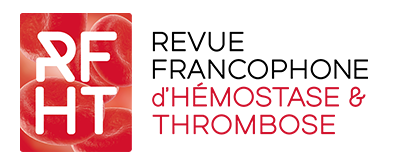RÉSUMÉ
L’hémophilie A acquise (HAA) est une maladie hémorragique auto-immune rare causée par la présence d’auto-anticorps dirigés contre le facteur VIII (FVIII), et dont le taux de mortalité est élevé. Les recommandations internationales définissent la rémission complète par l’association d’un inhibiteur indétectable 1< 0,6 unité Bethesda/ml) et d’une activité du FVIII (FVIII:C) normale, persistant après l’arrêt du traitement immunosuppresseur. Pour les patients en rémission, le risque de rechute avoisine les 20 %. Dans cette étude, nous avons étudié la précision du rapport FVIII:C/dosage antigénique du facteur von Willebrand (VWF:Ag) pour prédire une rechute chez 64 patients atteints d’HAA. Dans cette cohorte, tous les patients avaient un rapport FVIII:C/VWF:Ag effondré au moment du diagnostic, et cette valeur a progressivement augmenté au cours des premières semaines de traitement immunosuppresseur. Dans notre étude, 9/64 (14 %) n’ont pas obtenu de rémission complète. Chez 22 patients qui n’ont pas rechuté, le rapport FVIII:C/VWF:Ag est resté normalisé (> 0,7). En revanche, chez les 5 patients qui ont rechuté pendant le suivi, nous avons constaté soit une absence de normalisation du rapport FVIII:C/VWF:Ag, soit une diminution après la normalisation initiale. Chez tous les patients qui ont rechuté, une évolution défavorable du rapport a toujours été le premier résultat biologique anormal à être observé, avant l’allongement du temps de céphaline activée (TCA), de la diminution du FVIII:C et de la réapparition de l’inhibiteur anti-FVIII. Ces données suggèrent que le rapport FVIII:C/VWF:Ag pourrait être considéré comme un marqueur biologique sensible du suivi, pour prédire une éventuelle rechute en HAA.
MOTS CLÉS
facteur VIII, facteur von Willebrand, hémophilie A acquise
ABSTRACT
Acquired hemophilia A (AHA) is a rare autoimmune bleeding disorder with a high mortality rate caused by the presence of auto-antibodies against coagulation factor VIII (FVIIII. International recommendations define complete remission as undetectable inhibitor (<0.6 Bethesda Units (BU/mL)) and normal FVIII activity that persists after immunosuppressive therapy has been stopped. For patients achieving remission, the risk of relapse reaches 20%. With the aim to detect relapse, and then avoid associated bleedings, we assessed the accuracy of the FVIII/W ratio (FVIII:C/von Willebrand Factor Antigen (VWF:Ag) ratio) to predict relapse in 64 consecutive patients with AHA. In this cohort, all patients had a very low FVIII/W ratio at the time of diagnosis, and this value progressively increased in the first weeks of immunosuppressive treatment. In our study, 9/64 (14%) did not achieve complete remission. Twenty-seven patients were followed long enough (more than a year) to show that in the 22 patients who did not relapse, the FVIII/W ratio remained durably normalized (>0.7). By contrast, in the 5 patients who relapsed during follow-up, we noted either no correction of the FVIII/W ratio, or a secondary decrease to an abnormal value of <0.7 after an initial normalization. In all patients who relapsed, an abnormal evolution of FVIII/W ratio was the first abnormal biological result to be observed, always preceding changes in activated partial thromboplastin time (aPTT), FVIII:C decrease and anti-FVIII reappearance. These data suggest that the FVIII/W ratio could be considered as a sensitive biological marker to predict recovery and/or relapse in AHA.
KEYWORDS
acquired hemophilia A, factor VIII, Von Willebrand factor

